Small Business Survey Scotland: 2017
Sets out the findings for Scotland of the Small Business Survey 2017.
This document is part of a collection
4. Business Practice
Innovation
This section relates to SMEs that had engaged in any kind of innovation, i.e. good/service or process innovation.
40 per cent of SMEs in Scotland had innovated (i.e. had introduced new or significantly improved goods, services or processes) in the last three years, broadly in line with the UK as a whole (41 per cent). The proportion of SMEs that had innovated was broadly in line with the prior year in Scotland (38 per cent) and up marginally from the prior year in the UK as a whole (39 per cent) [13] .
Innovation (good/service/process) was more common amongst medium-sized businesses (57 per cent) compared to SMEs as a whole. By sector, innovation (good/service/process) was more common in the Information/Communication (66 per cent) and Manufacturing (52 per cent) sectors and less prevalent in the Construction (19 per cent) and Administrative Services (22 per cent) sectors (Figure 2).
Figure 2: SMEs introducing new or improved goods/services/processes in the last 3 years by sector
Base: all SME employers, 739 - Base minimum: Information/Communication, 28
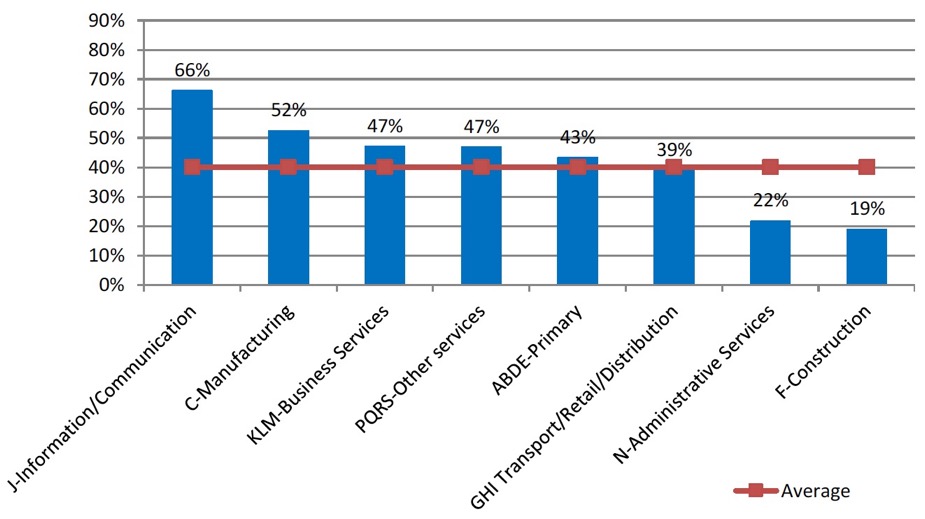
Good/service innovation
This section relates to SMEs that had engaged in good/service innovation.
34 per cent of SMEs in Scotland had introduced new or significantly improved goods or services in the last three years, broadly in line with the proportion in the UK as a whole, at 35 per cent. The proportion of SMEs that had engaged in goods/services innovation was broadly similar compared to the prior year in Scotland (32 per cent) and marginally higher than the prior year in the UK as a whole (33 per cent) [14] .
Of those SMEs that had introduced new or improved goods or services, 72 per cent introduced innovations that were all just new to the business and 24 per cent introduced at least some innovations that were also new to the market.
Good/service innovation was broadly similar across all firm sizes (micro/small/medium). Good/service innovation was more prevalent in the Information/Communication (63 per cent) and Other Services sectors (44 per cent), while it was less prevalent in the Administrative Services (18 per cent) and Construction sectors (16 per cent) (Figure 3).
Figure 3: SMEs introducing new or improved goods/services in the last 3 years
Base: all that introduced new or improved goods/services, 273
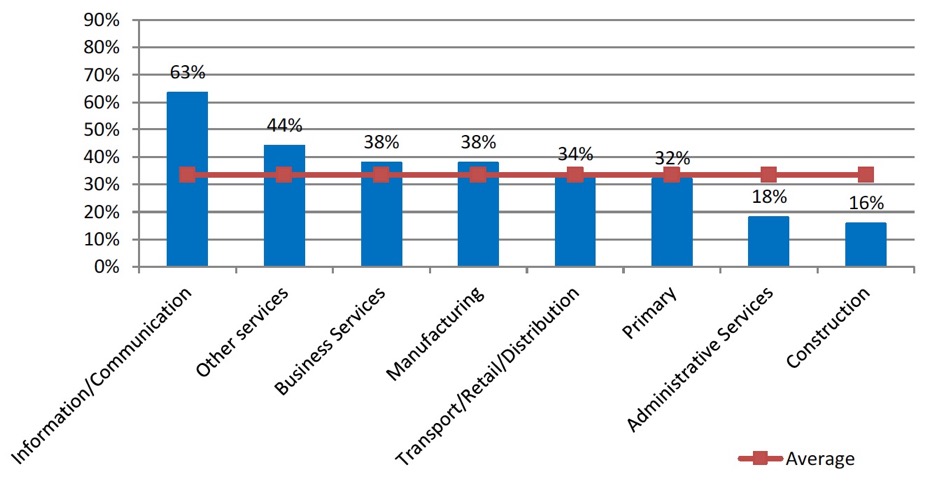
Process innovation
This section relates to SMEs that had engaged in process innovation.
20 per cent of SMEs in Scotland introduced new or significantly improved processes for producing or supplying goods or services in the last three years, unchanged from the prior year and in line with the proportion in the UK as a whole (20 per cent).
Of those SMEs that had introduced new or improved processes, 77 per cent introduced process innovations that were all just new to the business, while 18 per cent introduced at least some process innovations that were also new to the market [15] .
Process innovation was more common amongst medium-sized (42 per cent) and small firms (28 per cent). By sector, process innovation was higher than average in the Manufacturing sector (35 per cent). All other sectors were broadly in line with the overall
Figure 4: SMEs introducing new or improved processes in the last 3 years
Base: all that introduced new or improved processes, 185
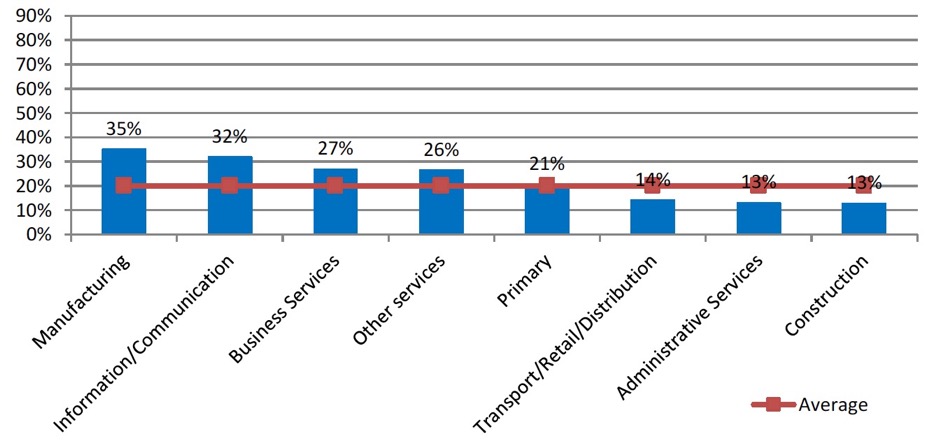
Training
51 per cent of SMEs in Scotland had arranged or funded any training (off the job training [16] and/or on the job training [17] ) in the past 12 months, broadly in line with the proportion in the UK as a whole (49 per cent). The figure in Scotland was broadly in line with the prior year when it stood at 54 per cent (in the UK as a whole, the proportion was lower than in the prior year when it stood at 55 per cent).
Table 3 below shows the proportions of SMEs in Scotland that had arranged or funded any training in the past 12 months. Medium-sized and small businesses were much more likely than average to have arranged or funded training.
| Table 3: SMEs that had arranged or funded training in the past 12 months by size (%) Base: all SME employers, 739 |
||||
|---|---|---|---|---|
| Micro 1-9 |
Small 10-49 |
Medium 50-249 |
All |
|
| Any training |
45 |
79 |
83 |
51 |
| Off the job |
37 |
65 |
73 |
42 |
| On the job |
29 |
65 |
68 |
36 |
Figure 5 below shows the proportion of SMEs in each sector that had arranged or funded any training in the past 12 months. Businesses in the Other services sector were more likely than average to have arranged or funded any training (65 per cent), while businesses in Transport/Retail/Distribution were less likely than average to have arranged or funded any training (41 per cent).
Figure 5: SMEs that had arranged or funded training in the past 12 months by sector (%)
Base: all SME employers, 739 – Base minimum: Information/Communication, 28
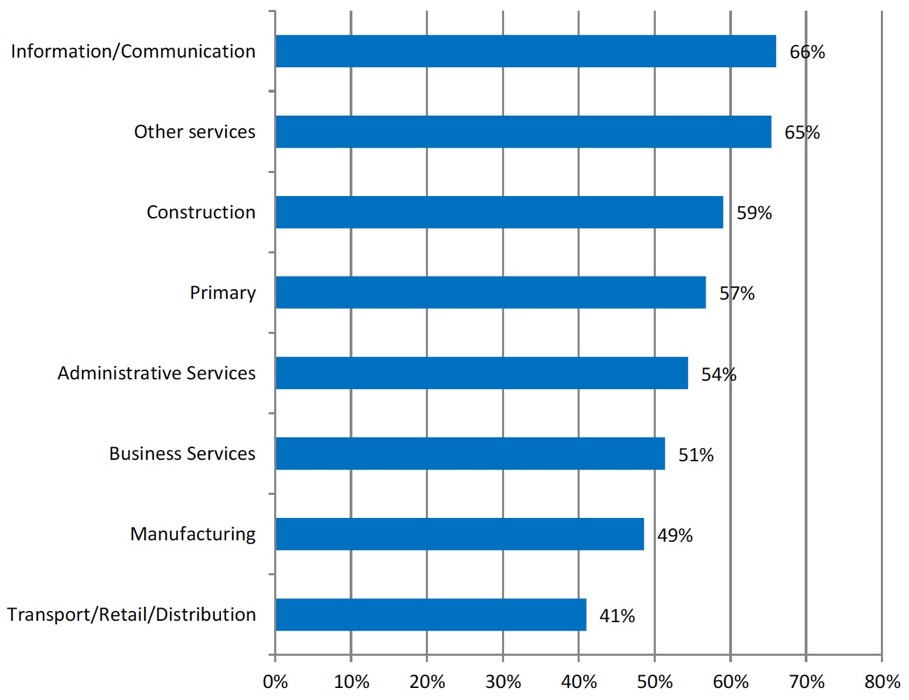
33 per cent of SMEs in Scotland had arranged or funded any training (off the job training and/or on the job training) for managers in the business in the past 12 months, broadly in line with the proportion in the UK as a whole (32 per cent).
The most common forms of training that managers received were technical, practical or job-specific skills (80 per cent), health and safety (76 per cent) and leadership and management skills (41 per cent) (Figure 6).
Figure 6: Types of training for managers (%)
Base: all that offered training for managers, 351
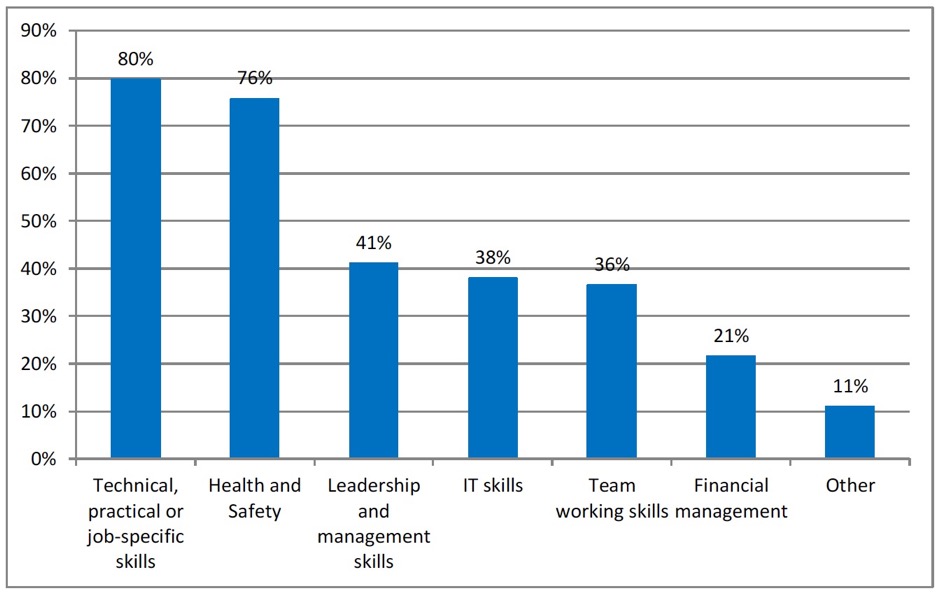
Apprenticeships [18]
12 per cent of SMEs in Scotland offered formal apprenticeships (i.e. apprenticeships that lead to a recognised qualification) in the last three years. This was broadly in line with the figure in 2016 (14 per cent) and in line with the proportion in the UK as a whole (12 per cent).
Small (24 per cent) and medium-sized businesses (34 per cent) were more likely than average to have offered formal apprenticeships in the last three years.
Apprenticeships were most common in the Construction sector (22 per cent) (Figure 7).
Figure 7: Formal apprenticeships in the last 3 years by sector (%)
Base: all that offered formal apprenticeships in the last 3 years, 135
Base minimum: Information/Communication, 28
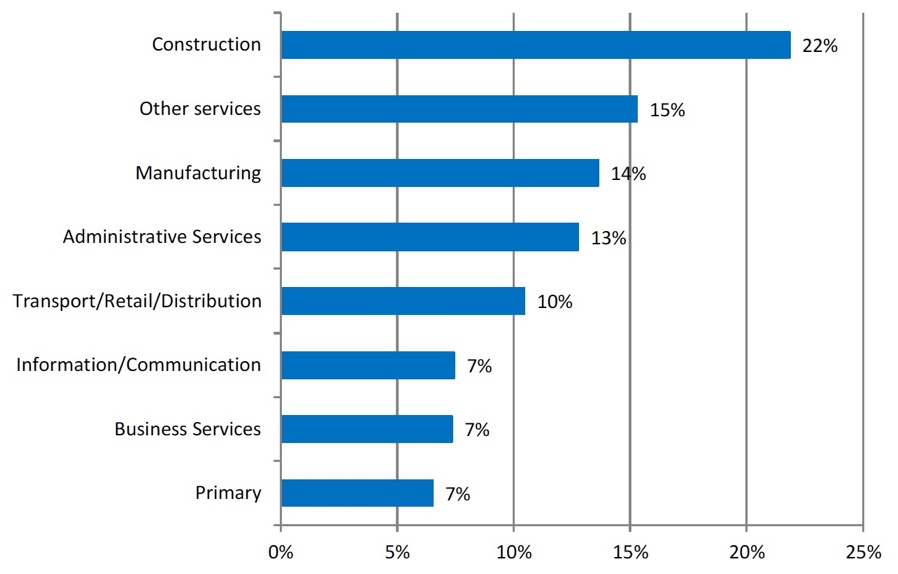
Of those SMEs that were not offering formal apprenticeships, the vast majority (87 per cent) were not intending to have an apprenticeship start in the next 12 months.
Business plan
In 2017, 34 per cent of SMEs stated that they had a formal written business plan which was kept up-to-date (broadly in line with the proportion in the UK as a whole, at 35 per cent). Small (46 per cent) and medium-sized firms (61 per cent) were more likely than average to have an up-to-date business plan.
Business support
In 2017, 32 per cent of SMEs had used external information or advice on matters affecting their business in the previous 12 months, in line with the proportion in 2016 (32 per cent), and broadly in line with the proportion in the UK as a whole (29 per cent).
The most common reason for using information or advice was financial advice e.g. accounting or general running of business, cited by 22 per cent of SMEs that used information or advice in 2016 (Figure 8).
Figure 8: Reasons for using information or advice (%)
Base: all that used information or advice, 261
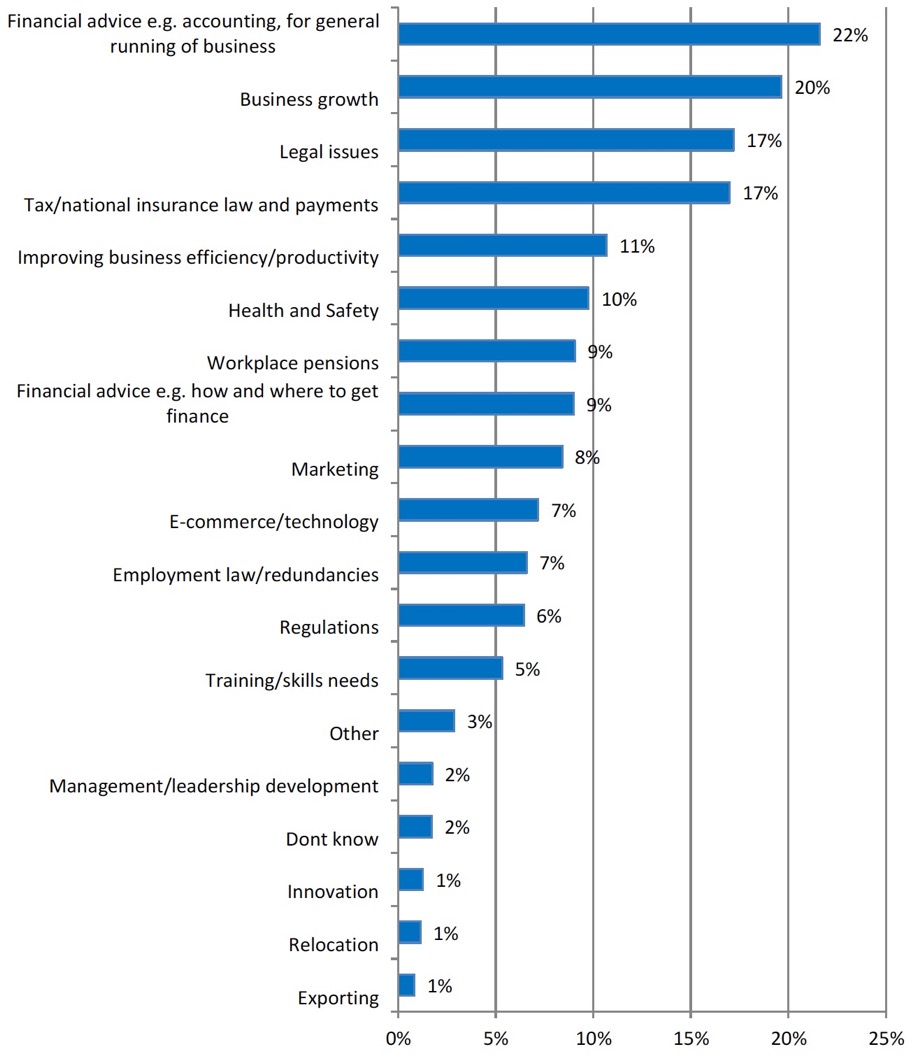
In 2017, the most common source of information or advice for SMEs in Scotland was their accountant, cited by 41 per cent of SMEs that used advice in the previous 12 months and business networks/trade associations (27 per cent).
Living Wage
This section examines issues related to the payment of the Living Wage, as defined by the Living Wage Foundation. Businesses can choose to pay the Living Wage to all their directly employed staff, aged 18 or above, on a voluntary basis. At the time the 2017 survey began, the Living Wage was set at £8.45 per hour outside London and rose to £8.75 from November 2017. It should be noted that the Living Wage, as defined by the Living Wage Foundation, is different from the National Living Wage which is the legal minimum wage for employees in the UK.
In 2017, 70 per cent of SMEs in Scotland paid all their employees aged 18 or over (excluding volunteers, apprentices and interns) at or above £8.45 per hour, the Living Wage as defined by the Living Wage Foundation at the time the survey began. 28 per cent of SMEs did not pay the Living Wage to all their employees and two per cent did not know. These proportions are broadly in line with the previous year. Small (57 per cent) and medium-sized firms (59 per cent) were less likely than average to pay the Living Wage (Figure 9).
Figure 9: SMEs paying the Living Wage as defined by the Living Wage Foundation (%)
Note: the Living Wage stood at £8.45 per hour for the 2017 survey.
Base: all SMEs employers, 739
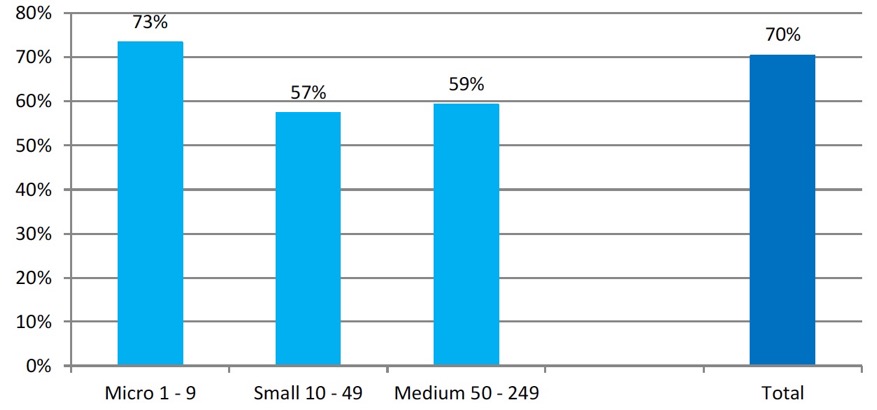
By sector, SMEs in the Information/Communication (93 per cent), Construction (89 per cent), Primary (88 per cent) and Business Services (85 per cent) were more likely than average to pay the Living Wage. Businesses in the Transport/Retail/Distribution sector (48 per cent) were less likely than average to pay the living wage. Figure 10 shows the proportions of SMEs paying the Living Wage by sector.
Figure 10: SMEs paying the Living Wage by sector (%)
Base minimum: Information/Communication, 36
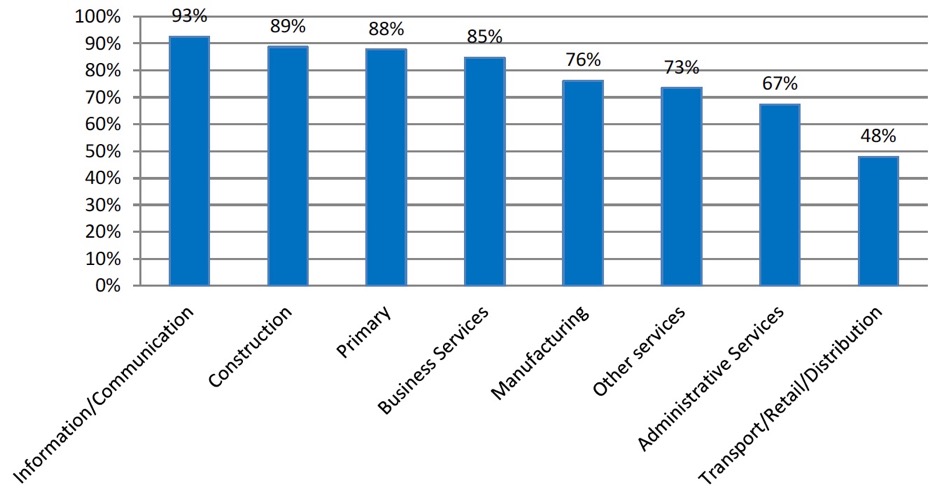
Three per cent of SMEs surveyed in Scotland stated that they received accreditation as a living wage employer from the Living Wage Foundation, broadly in line with the proportion in the prior year (two per cent). 91 per cent stated that they had not and five per cent did not know.
Awareness of Scottish Business Pledge
In 2017, 16 per cent of SMEs in Scotland were aware of the Scottish Business Pledge, while the vast majority were not aware of it (83 per cent) [19] .
Engagement with local community
65 per cent of SMEs in Scotland considered their business to be actively involved in their local community, while 34 per cent did not. These proportions are broadly in line with the prior year. Small firms were more likely than average to consider their business to be actively involved in their local community (74 per cent).
Engagement with ‘best practice’ schemes
Figure 11 shows the proportions of SMEs that engaged with a range of ‘best practice’ schemes.
Figure 11: SMEs engaging with ‘best practice’ schemes
Base: all SMEs employers, 739
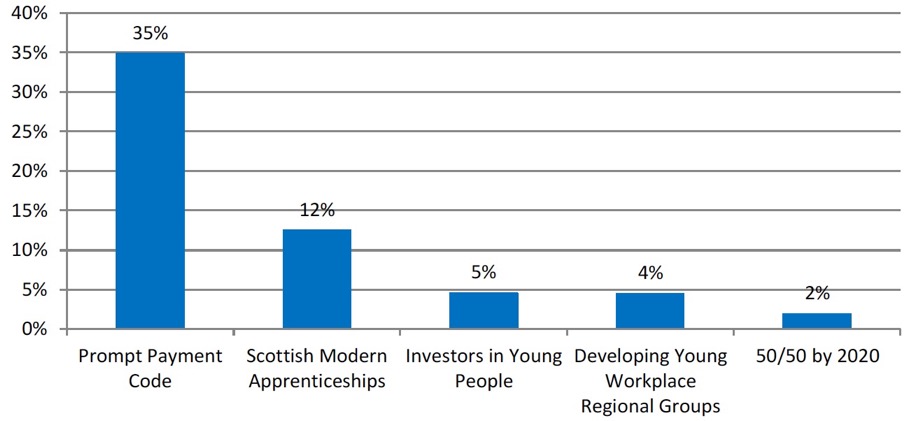
35 per cent of SMEs engaged with the Prompt Payment Code, a higher proportion than the previous year (20 per cent). 12 per cent of SMEs engaged with Scottish Modern Apprenticeships, in line with the proportion in the previous year. Just two per cent of SMEs were engaged with the 50/50 by 2020 gender balance commitment.
Working hours arrangements
Figure 12 below shows the proportion of SMEs offering a range of working hours arrangements to their employees. The most common working hours arrangement was flexitime, offered by 54 per cent of SMEs. Seven per cent of SMEs offered zero hours contracts. 31 per cent of firms offered none of these arrangements to their staff.
Figure 12: Working hours arrangements available to employees (%)
Base 2017: all SME employers, 739
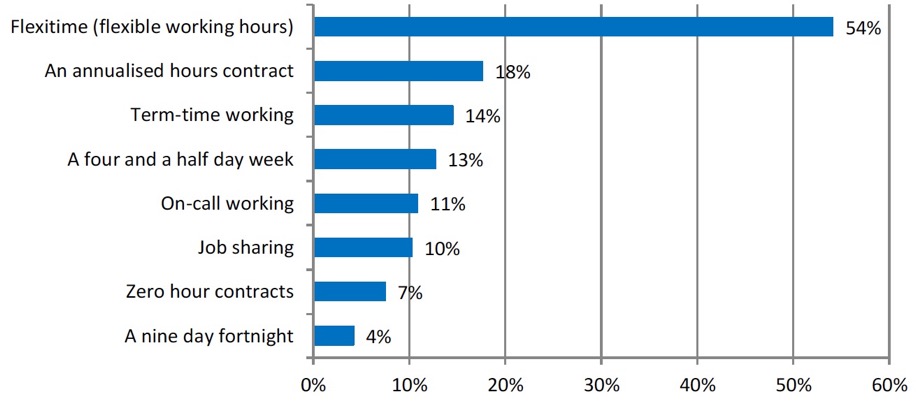
Contact
There is a problem
Thanks for your feedback